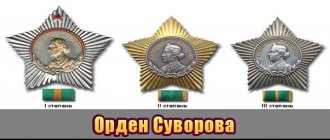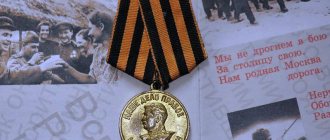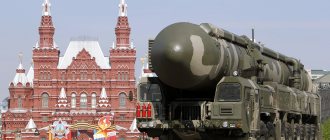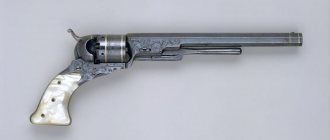The US state award system differs significantly from the Russian and most other countries. It is based on military awards, with civilians awarded primarily on behalf of organizations and companies, and the state rarely rewards its citizens for any peaceful achievements. In addition, in the award system there is no division into orders and medals; they are all arranged in a single hierarchical structure. Thus, the highest American award is the US Congressional Military Medal (or Honor). In general, all types of military decorations are considered the most senior. In addition to them, there are several other types of award badges, many of which are represented by a huge number of options.
Features of American awards
All award options in the USA are divided into 7 main groups, which in order of seniority are as follows:
- military - to encourage military personnel;
- military – to encourage military units/units;
- non-military - awarded by non-military departments, organizations, state governments, etc.;
- for impeccable service - to reward employees in various federal departments;
- commemorative - awarded personally to participants in a war, campaign or other significant events, actions, events;
- Ribbons for Service and Learning - a type of reward for professionalism or academic success;
- State Awards for Guardsmen - established in each state for members of the American National Guard.
Wearing all of these awards has its own characteristics:
- Military personnel wear not only those personally trained, but also military medals and orders of the United States awarded to the unit in which they serve. At the same time, only direct participants in the event that became the reason for awarding the military unit receive the right to wear some of them. Others may only be worn while serving in the awarded unit, regardless of participation in the designated event.
- If a serviceman is repeatedly awarded the same badge, then the second one is not worn. Instead, a corresponding mark in the form of a number, letter, leaf or other designation is added to the award ribbon, indicating the presence of two or more awards.
- Almost every award has a miniature. The choice of a full-size sign or a mini-copy of it depends on the type of uniform.
When wearing several awards, they are ranked according to seniority, which is determined by the degree of honor and is reflected in the hierarchy of the award system.
The most relevant award of 2022
The United States, especially the actions of its armed forces, can be treated differently. I am not making any judgments in this article. My task is not to label, but only to review specific awards. One way or another, it is unlikely that any of us will ever receive one of the main US medals. But almost everyone today has the opportunity to receive the most relevant award of this year: the international personalized medal “For contribution to the fight against coronavirus,” established by the award committee. All categories of citizens of both Russia and other countries, including the United States, are eligible to receive the medal. After all, according to the committee, each of us deserves a reward for the fight against coronavirus. You can order the medal “For Contribution to the Fight against Coronavirus” on the website
Major US military awards
The vast majority of American awards are represented by military medals, which are awarded to military personnel for courage or successful service. There are quite a few badges in this category. The youngest in this hierarchy is the combat ribbon, which marks each participant in the hostilities. The main military and, accordingly, American awards in general are considered to be 5:
- the highest - the Medal of Honor (or the US Congress);
- then there are 3 crosses of equal rank, which are divided by branch of service - army, navy and air force;
- fifth - Silver Star.
All of them are awarded only for courage shown in battle. Also important are the peacetime awards - “For Outstanding Service” and “Legion of Honor”.
Medal of Honor
The United States Medal of Honor (or Congressional Medal) is the highest award given to American military personnel. It is the only one approved by Congress and presented on its behalf by the president. In the Russian version, it is equal to the Golden Star of the Hero.
According to the statute, this distinction can only be awarded to American military personnel who, in combat, committed a courageous act at the risk of their own life beyond what is established by military duties.
The history of “honorary” awards dates back to the Civil War of 1861-1865, when they were awarded to heroes of the struggle against the Confederacy. Today, the award badge is presented in 3 versions - for the Army, Air Force and Marine Corps with the Coast Guard (Navy). They all have the same size and ribbons, and some design features are determined by their belonging to a specific branch of the military.
To be nominated for an award, multiple confirmation by testimony of the fact of committing a unique act, demonstrated courage and self-sacrifice in conditions with maximum risk to life is required. All evidence is carefully verified, and only after complete proof can approval by Congress follow.
The Medal of Honor was created in 1862 by President Lincoln, initially only to reward lower ranks for heroism in battle. But a year later, Congress included officers in the list of possible candidates.
Three Crosses
The 3 types of the Cross are considered second in order of seniority - army, naval and air force. The awards began immediately after the approval of the Cross in early 1918 and were intended for military personnel who committed a life-threatening heroic act, the significance of which was considered insufficient to receive the Medal of Honor.
The merits for which American soldiers receive the corresponding Cross today include:
- heroic deeds in battles with external enemies;
- demonstrated military valor in a military conflict with another state;
- the same valor shown in service in the army of an allied country.
All three badges have a 5-corner block with moiré ribbons in three shades of blue. The front side of the Cross of Merit is decorated with an eagle with open wings, the Air Force Cross is decorated with a flying eagle, and the Navy Cross is decorated with the ship of Columbus, who discovered the New World.
Nominations for the award may only be made by the highest command of the Army, Navy, Marine Corps or Coast Guard. Decorated representatives of soldiers and sergeants after 20 years of service receive a 10% increase in pension.
"Silver Star"
The Silver Star is the fifth of the major military medals, which is awarded for the same merits as the previous ones, but their significance is considered lower. It was established in 1918 to reward military personnel for exceptional courage during hostilities. At first the sign was called the “Star of Merit”, and in 1932 it received a new name, which is still in effect today.
The medallion is made in the form of a golden star, which is attached to a blue-white-red moire ribbon. The distance between the ends of the rays is 2.54 cm, the middle of the star is framed by a wreath of laurel, and in the very center there is a small star superimposed on diverging rays reminiscent of the sun. On the reverse side it is written “For bravery in battle.”
Nowadays, military personnel who, in the performance of their official duties, brought maximum benefit during the war period or in special peacetime conditions, are nominated for awards. Civilians whose merits are equivalent to the specified military merits may also be awarded.
"For distinguished service"
Despite ranking sixth in the hierarchy, the Distinguished Service Medal is considered the highest "peace" award. It is awarded to the US Department of Defense for exceptional achievements in strengthening the country's defense capabilities. Most often, it is awarded to representatives of the highest rank at the level of the head of the chiefs of staff committee and the chiefs of staff themselves.
The Distinguished Service Badge was established in 1918. Military personnel who, in the performance of their official duties, brought the maximum benefit during the war period or were just as useful in special peacetime conditions are also nominated for the award. Civilians whose merits are equal to the specified military merits can also be awarded.
"Legion of Honor"
The Legion of Honor has 4 degrees. It was established in 1942 and in its original version it was intended to be the second highest military award, awarded for heroic deeds. But then they decided to use the first 3 degrees to reward employees of the allied armies, and the lowest IV degree - for American soldiers of all branches of the military.
The Legion of Honor badge of the IV degree is made in the form of a green laurel wreath with a star with V-shaped rays superimposed on it. The reverse side contains the full name of the country and space for engraving the recipient's name.
A characteristic feature of this badge is that it is the only one in the entire award system called an order, while no other US orders are listed anywhere.
The price of “Victory” and the winners
In the USSR, the Order of Suvorov 1st degree, the highest of the military commanders with the exception of the Order of Victory (there was no equivalent to the latter in the American award system), was received three times by Air Chief Marshal Konstantin Vershinin, Artillery Marshal Vasily Kazakov, Army General Alexander Luchinsky and Colonel General Ivan Lyudnikov .
All of them also had one Order of Suvorov, 2nd degree. Only three Orders of Suvorov 1st degree were awarded to Army General Pavel Batov, Colonel General Pavel Belov, Chief Marshal of Artillery Nikolai Voronov, Chief Marshal of Aviation Alexander Golovanov, Colonel General Vasily Gordov, Marshal Andrei Eremenko, Army General Vladimir Kolpakchi, Chief Marshal of Aviation Alexander Novikov, Colonel General Nikolai Pukhov, Marshal of the Armored Forces Pavel Rybalko, Marshal Vasily Sokolovsky, Marshal Semyon Timoshenko, Colonel General Vyacheslav Tsvetaev and Marshal Vasily Chuikov. Marshals and Army General Alexei Antonov, awarded the Order of Victory, as a rule, had only two Orders of Suvorov, 1st degree. The only exception is Marshal Timoshenko, who, with three Orders of Suvorov, 1st degree, on June 4, 1945, was nevertheless presented with the Order of Victory together with Antonov. This turned out to be the penultimate presentation of this highest order to Soviet military leaders. Meretskov was the last to receive it on September 8. The third, “consolatory” Order of Suvorov was awarded to Semyon Timoshenko on April 27, 1945. Perhaps Stalin experienced some hesitation about whether to include Timoshenko in the narrow circle of Knights of Victory. But in the end he relented. Probably the decisive factor was the fact that Tymoshenko’s daughter Ekaterina was the wife of Vasily Stalin, who, by the way, ended the war as an aviation colonel, commander of the 286th Fighter Aviation Division and holder of the Order of Suvorov, 2nd degree. Or maybe Stalin took into account the quick capture of Vienna on April 13 by the fronts supervised by Timoshenko.
But Timoshenko did not play a prominent role in the club of Knights of the Order of Victory. If we take the holders of the three Orders of Suvorov, 1st degree, then the vast majority of them ended the war as army commanders (Vershinin, Luchinsky, Lyudnikov, Belov, Gordov, Kolpakchi, Pukhov, Rybalko, Tsvetaev, Chuikov). Kazakov became the chief of artillery of the front, and Voronov became the chief of artillery of the Red Army, but due to his failing health, he largely retired and in the last year and a half of the war he no longer traveled as a representative of Headquarters to the front. Golovanov commanded long-range aviation, Eremenko commanded the 4th Ukrainian Front, Novikov was the commander-in-chief of the Air Force, Sokolovsky was the deputy commander of the 1st Belorussian Front, and Timoshenko was the representative of the Supreme Commander-in-Chief Headquarters. In this capacity, he was still considered Stalin’s commander of the 1st rank, which is why he received the Order of Victory. The gentlemen of the three Orders of Suvorov, 1st degree, although promising and, from Stalin’s point of view, outstanding commanders, still constituted the 2nd rank. And they were not guaranteed against repression.
Vasily Nikolaevich Gordov, in conversations with his wife and colleagues, spoke harshly about Stalin and his policies. The MGB recorded these conversations and reported them to Stalin. At the beginning of 1947, Gordov was arrested, and on August 24, 1950, he was shot on charges of hatching terrorist plans against members of the Soviet government. Air Chief Marshal Novikov was arrested at the beginning of 1946 and on May 11, 1946, sentenced to five years in prison in the so-called aviation case - for supplying defective aircraft to the troops. He remained in prison until Stalin's death.
All holders of the three Orders of Suvorov, 1st degree, with the exception of Chief Marshals Voronov and Golovanov, became Heroes of the Soviet Union, and Novikov, Batov and Rybalko were awarded this title twice. Perhaps, in the eyes of Stalin, the title of Chief Marshal seemed to replace the “Star” of the Hero.
The Order of Ushakov, 1st degree, was a much rarer award than its land counterpart, the Order of Suvorov, 1st degree. In total, 26 people had the Order of Ushakov, 1st degree, including 11 with two. These 11 constituted the elite of the Navy, since not a single admiral received the Order of Victory. Two Orders of Ushakov, 1st degree, each went to the People's Commissar of the Navy, Fleet Admiral Nikolai Kuznetsov, his first deputy, Fleet Admiral Ivan Isakov, the Fleet Aviation Commander, Air Marshal Sergei Zhavoronkov, the Deputy People's Commissar for Shipbuilding, Admiral Lev Galler, the Deputy People's Commissar, Admiral Gordey Levchenko, and the Northern Fleet Commander, Admiral Arseny Golovko, Commander of the Black Sea Fleet Admiral Philip Oktyabrsky, Commander of the Baltic Fleet Admiral Vladimir Tributs (by the way, he was awarded the Order of Ushakov 1st degree No. 1), Commander of the Baltic Fleet Aviation Colonel General Mikhail Samokhin, Commander of the Black Sea Fleet Aviation Colonel General aviation Vasily Ermachenkov and the commander of the Danube military flotilla, Vice Admiral Georgy Kholostyakov (he also had the Order of Suvorov, 1st degree - for the battles on Malaya Zemlya).
Like the Order of Suvorov, the Order of Ushakov did not provide any immunity from persecution. In 1948, Admiral Kuznetsov was convicted by the “court of honor” and the Military Collegium of the Supreme Court in a trumped-up case of illegally transferring drawings and descriptions of a high-altitude parachute torpedo to the Allies. He was removed from his post as People's Commissar and demoted to rear admiral. True, already in 1951 he again headed the Navy, but only with the rank of vice admiral and without expunging his criminal record. But Admiral Haller was sentenced to four years in prison in the same case. He died in the Kazan prison psychiatric hospital on July 12, 1950.
Non-military medals
Members of the US military are permitted to wear award badges received from non-military organizations at least at the federal level. Among the most common non-military awards are medals: Presidential, Freedom, National Security, “For Saving People,” “Outstanding Civil Merit” and others.
No other badges from governments or agencies at the state level or below may be attached to the uniform. It is also prohibited to wear any non-military insignia that is similar in appearance to military insignia.
France
The Legion of Honor, France's highest military and civilian award, was created by Napoleon Bonaparte in 1802. It is not only a badge of honor, but also an organization for the recipients, although in recent decades this factor has faded into the background. The order has five degrees. In ascending order, these are Knight, Officer, Commander, High Officer and at the very top - Knight Grand Cross.
In the 19th century, holders of the order, and this mainly concerned the military, received decent awards, but now they are purely symbolic. Among the order bearers with Russian roots one can single out Zinovy Peshkov, the adopted son of Maxim Gorky, and the brother of the fiery Bolshevik Yakov Sverdlov.
As for the Grand Cross, in our time only Vladimir Putin was awarded it.
Prepared by Vyacheslav Prokofiev
"For impeccable service"
The United States Meritorious Service Medals are awarded by various federal agencies for conscientious performance of official duties or duty. Badges from other federal departments are permitted to be worn on Army uniforms, but they will be inferior in status to the respective military personnel.
Each department has many options for awards with different names. It is simply unrealistic to list them all.
The War Department established the Distinguished Service Award in 1941 to reward enlisted personnel for dedicated service and exemplary conduct. The medallion is made of bronze in the shape of a circle with a diameter of 2.79 cm. The front side is decorated with an eagle with spread wings, which sits on a closed book. The phrase “Loyalty, Honor, Efficiency” is written around the circle.
So, what kind of medals are awarded overseas?
Among the most important US military awards are the Congressional Medal of Honor (Medal of Honor), the Distinguished Service Cross, the Navy Cross, the Air Force Cross and the Silver Star Medal. Each of these five awards is awarded only for personal bravery in combat. They are not given for participation in a particular military campaign or for length of service. The highest award of the United States is the Congressional Medal. The rank below is three equivalent crosses for different branches of the military: the cross “For Special Merit”, the crosses of the Navy and the Air Force. The Silver Star medal completes the list.
Commemorative medals
This category includes personal awards that are presented to military personnel who participated in a war, military campaign, other similar event or significant event.
Among the commemorative medals are: for the defense of America, the Women's Army Corps, the Pacific-Asian campaign, National defense, the European-African-Middle Eastern campaign, Victory in World War II, Humanitarian actions, as well as Korean, Antarctic, Vietnam and others.
Service and Training Ribbons
This type of award is awarded in the USA for exemplary performance of official duty, high professionalism, and academic success. Such badges are made in the form of strips covered with ribbons of a certain color and externally reminiscent of order strips.
There are the following main types of tapes:
- military service;
- professionally developed sergeant;
- Army Reserve training abroad.
Each ribbon is marked with numbers indicating the level of qualification:
- 2 – main;
- 3 – high;
- 4 – sergeants after graduating from the school of chief sergeants or with a similar level of qualification.
A ribbon without numbers is awarded at the initial level of qualification.
Silver Star
The Silver Star is the U.S. Army's third highest combat award for valor. The merits of a recipient of the Silver Star must be sufficiently significant, but not exceed the merit of recipients of the Congressional Medal and the Cross.
- Since the medal's inception in 1932, it has been awarded to more than 100,000 military personnel.
- The first recipient was General Douglas MacArthur.
- Of the latter, two women can be noted: Sergeant Lee Anne Hester (Iraq, 2005) and Monica Lee Brown (Afghanistan, 2008).
State Awards for Guardsmen
In each US state, special award options have been established for members of the National Guard, the number of which varies from a few to several dozen. They are awarded exclusively to representatives of the National Guard.
Military personnel of other units and divisions are not awarded, but can wear the badge if they previously served in the guard and received it legally. In the hierarchy of the award system, these badges are the most junior and are attached below all others.
Japan
In Japan there is no direct analogue to the title Hero of the Soviet Union, but the closest thing to it is, perhaps, the Order of the Rising Sun - the third most senior order in Japan. Established in 1875, when Japan began internal reforms, while borrowing many things from Europe and the United States.
This order was originally called the Imperial Meiji Order, but a few years later received its current name.
Until 2003, it was awarded only to men for both military and civilian merit.
One of the first European holders of the Order of the Rising Sun (and the first among the subjects of the Russian Empire) was Lieutenant General Ivan Zarubin. The Emperor of Japan presented him with the order in 1881, when Zarubin visited the country as a flagship mechanic at the headquarters of the commander of Russian naval forces in the Pacific.










